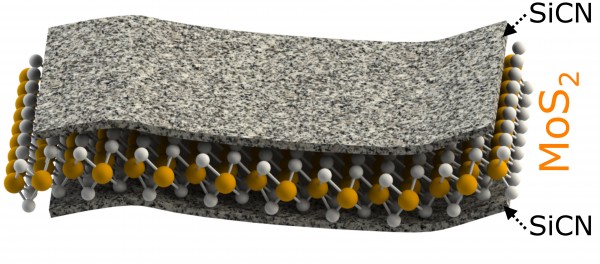Nano ‘sandwich’ improves rechargeable lithium batteries
April 20, 2015

Molybdenum disulfide sheets — “sandwiches” of one molybdenum atom between two sulfur atoms — may improve rechargeable lithium-ion batteries (credit: Kansas State University)
The key to better cellphones and other rechargeable electronics may be tiny “sandwiches” made of nanosheets of molybdenum disulfide (MoS2), according to Kansas State University assistant professor of mechanical and nuclear engineering Gurpreet Singh and his research team.
The research is focused on improving rechargeable lithium-ion batteries. The team has focused on lithium cycling of sheets, which Singh describes as a “sandwich” of one molybdenum atom between two sulfur atoms.
In the latest research, the team found that silicon carbonitride-wrapped molybdenum disulfide sheets show improved stability as a battery electrode, with little capacity fading.
The open-access findings appear in Nature’s Scientific Reports.
Extending storage time
Singh’s team observed that molybdenum disulfide sheets store more than twice as much lithium — or charge — than bulk molybdenum disulfide reported in previous studies. The researchers also found that the high lithium capacity of these sheets does not last long and drops after five charging cycles.
“This kind of behavior is similar to a lithium-sulfur type of battery, which uses sulfur as one of its electrodes,” Singh said. “Sulfur is notoriously famous for forming intermediate polysulfides that dissolve in the organic electrolyte of the battery, which leads to capacity fading. We believe that the capacity drop observed in molybdenum disulfide sheets is also due to loss of sulfur into the electrolyte.”
To reduce the dissolution of sulfur-based products into the electrolyte, the researchers wrapped the molybdenum disulfide sheets with a few layers of a ceramic called silicon carbonitride, or SiCN. The ceramic is a high-temperature, glassy material prepared by heating liquid silicon-based polymers and has much higher chemical resistance toward the liquid electrolyte, Singh said.
“The silicon carbonitride-wrapped molybdenum disulfide sheets show stable cycling of lithium-ions irrespective of whether the battery electrode is on copper foil-traditional method or as a self-supporting flexible paper as in bendable batteries,” Singh said.
After the reactions, the research team also disassembled and observed the cells under the electron microscope, which provided evidence that the silicon carbonitride protected against mechanical and chemical degradation with liquid organic electrolyte.
Singh and his team now want to better understand how the molybdenum disulfide cells might behave in an everyday electronic device — such as a cellphone — that is recharged hundreds of times.
The researchers have received support from the National Science Foundation.
Abstract of Polymer-Derived Ceramic Functionalized MoS2 Composite Paper as a Stable Lithium-Ion Battery Electrode
A facile process is demonstrated for the synthesis of layered SiCN-MoS2 structure via pyrolysis of polysilazane functionalized MoS2 flakes. The layered morphology and polymer to ceramic transformation on MoS2 surfaces was confirmed by use of electron microscopy and spectroscopic techniques. Tested as thick film electrode in a Li-ion battery half-cell, SiCN-MoS2 showed the classical three-stage reaction with improved cycling stability and capacity retention than neat MoS2. Contribution of conversion reaction of Li/MoS2 system on overall capacity was marginally affected by the presence of SiCN while Li-irreversibility arising from electrolyte decomposition was greatly suppressed. This is understood as one of the reasons for decreased first cycle loss and increased capacity retention. SiCN-MoS2 in the form of self-supporting paper electrode (at 6 mg·cm−2) exhibited even better performance, regaining initial charge capacity of approximately 530 mAh·g−1 when the current density returned to 100 mA·g−1 after continuous cycling at 2400 mA·g−1 (192 mAh·g−1). MoS2 cycled electrode showed mud-cracks and film delamination whereas SiCN-MoS2 electrodes were intact and covered with a uniform solid electrolyte interphase coating. Taken together, our results suggest that molecular level interfacing with precursor–derived SiCN is an effective strategy for suppressing the metal-sulfide/electrolyte degradation reaction at low discharge potentials.